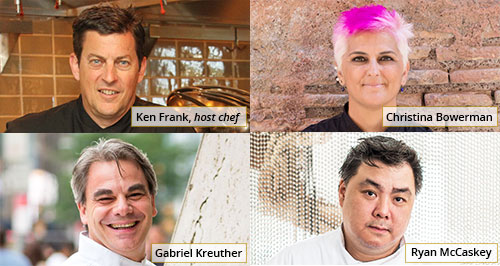 |
The Napa Truffle Festival’s spectacular lineup of Michelin star guest chefs for 2018 include Cristina Bowerman of Glass Hostaria in Rome, Gabriel Kreuther of Gabriel Kreuther in New York and Ryan McCaskey of Acadia in Chicago.
Why are these famous chefs participating in a festival about truffles? We asked them to share their truffle stories and culinary passions:
1. What is your first memory of eating and/or cooking with fresh black truffles?
Christina Bowerman (CB) – Eating rabbit with lentils. Served into a jar as soon as I opened it, the smell of black truffle inebriated me. Never found a better flavor combination.
Gabriel Kreuther (GK) – As a child on my parents’ farm in Alsace, we celebrated Easter Sunday with a family lunch. The first course was always foie gras terrine with a large chunk of truffle at the center. I would eat my terrine very quickly, saving the truffle for the end and making a tour of the table gathering truffle crumbs so that I could savor them with bread and butter!
Ryan McCaskey (RM) – I had heard of them, but never really had experienced them until the late 90’s when I was in Wisconsin. At first it was a white truffle on risotto. Shortly after, when I moved back to Chicago and worked at Vivere, we had them seasonally. It was the first time using an actual truffle! we had both white Albas and black Périgord.
2. Why do you like cooking with truffles?
CB – The truffle is versatile—fish, meat, veggies—there is no limit on what you can do with it. Pick one up, feel its weight in your palm, give it a very thorough sniff and, if you’re lucky to have a good one, it will emit a scent of incredible intensity that’s hard to describe. Their aroma helps lift up the flavors of other ingredients and leaves an amazing aftertaste.
GK – Because it grows underground and the unique way they are harvested, truffles have always been a fascinating product/mushroom for me! Also, I really like the way their flavor changes depending on how they’re treated, with the right amount of care and understanding. It is really satisfying when we get to their full aroma potential.
RM – I like how complex they can be. How they change from season to season and from area to area. I also like using them in interesting and unexpected or unusual ways. For example, in a sauce made with uni and banana. Or in an ice cream made with miso.
3. How would you describe the flavor/aroma of truffles?
CB – A combination of musk, nuts and ozone. The smell of truffles is hypnotizing. When the aroma hits you, you forget everything around you and you find yourself sitting on a Tuscan hill somewhere or maybe in the middle of the Napa Valley thinking how wonderful life is. And it’s true: truffles are from another world. But it is not true…they contain androstenone, a human pheromone, which contributes to its overwhelming aroma and often becomes the flavor itself.
GK – Slightly musky, light garlicky, a secondary odor of ether and gasoline when raw, intense and elegant at the same time. The flavor evolves and deepens as the season progresses. Strong umami when the quality is at its best and are treated properly. The way to buy them is by going with the Latin scientific names so that you have the right product in your hands: Tuber melanosporum for the black winter Périgord.
RM – I would say garlicky, mushroomy, fragrant, floral and musky.
4. How do you describe what a truffle looks like?
CB – A little black precious black stone with a bumpy surface that, if stretched, allows you into his awesome world!
GK – They can have various shapes, and could be compared to the shape of a medium to small potato, uneven in forms with crevices and knots. When they are the most perfect, they are nicely round and at least the size of a golf ball.
RM – It looks like a moon rock of some sort.
5. How would you entice someone who has never tasted truffles before to try them?
CB – By the smell, obviously! But when I prepare my sea urchin stuffed ravioli with “cacio and pepe,” it’s a done deal!
GK – By describing the flavor and having them taste it on something simple that magnifies the flavor of the truffle—a pasta dish, an egg dish, or cooked in a jar so that the encapsulated aroma is released when the jar is opened in front of them.
RM – I would have them close their eyes and smell the aroma first. Then give them a few thin slices to taste.
6. What is your favorite truffle dish?
CB – I particularly love beef tartare with black truffle. Of course, you need a poached egg on it! Also, potato gnocchi, sea urchin, black garlic bagna cauda and 60-month aged Parmesan stuffed ravioli with Isigny butter and truffle caviar.
GK – To me the best dishes that give justice to the black truffle are egg and pasta dishes. Also potatoes and leeks with foie gras cooked in a Mason jar that releases the flavor and aroma when it’s opened—simply combining all the senses.
RM – Ha ha – honestly, I love them on French fries and hash browns!
Throughout the festival weekend, you’ll have many opportunities to meet these culinary wizards, along with host chef Ken Frank of La Toque, as they discuss, demonstrate and prepare astounding truffle dishes for you to feast upon for breakfast, lunch and dinner!


